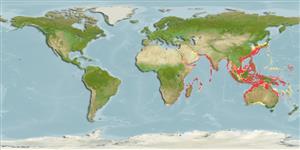>
Carangiformes (Jacks) >
Carangidae (Jacks and pompanos) > Caranginae
Etymology: Decapterus: Greek, deka = ten + Greek, pteron = wing, fin (Ref. 45335).
Eponymy: Dr Patrick Russell (1727–1805) was a British surgeon and naturalist. [...] (Ref. 128868), visit book page.
More on author: Rüppell.
Environment: milieu / climate zone / kisaran kedalaman / distribution range
Ekologi
laut bentopelagis; kisaran kedalaman 40 - 275 m (Ref. 12260). Tropical; 40°N - 36°S, 18°E - 172°E
Indo-West Pacific: East Africa to Japan, the Arafura Sea (Ref. 9819) and Australia. A Lessepsian migrant (Ref. 72453).
Length at first maturity / Size / Weight / umur
Kematangan: Lm 16.1, range 14 - 24.5 cm
Max length : 45.0 cm TL jantan/; (Ref. 9987); common length : 30.0 cm TL jantan/; (Ref. 9987); Berat maksimum terpublikasi: 110.00 g (Ref. 4883); Umur maksimum dilaporkan: 12 Tahun (Ref. 5406)
Duri punggung (Keseluruhan (total)) : 9; duri punggung lunak (Keseluruhan (total)) : 28 - 31; Duri dubur: 3; Sirip dubur lunak: 25 - 28; vertebrata, bertulang belakang: 24. Lateral line curved below soft dorsal and with 30-44 strong scutes; color bluish green above, silvery below; caudal fin hyaline to yellowish; dorsal fins hyaline basally, light dusky distally. Opercle with small, black spot; opercular membrane with smooth margin. Snout longer than eye diameter; squarish lower posterior edge of maxilla; upper jaw with small teeth anteriorly; soft dorsal and anal fins relatively low, not falcate; pectoral fin sub falcate. (Other source of data on morphology: Refs. 3131, 3197, 3287).
Body shape (shape guide): fusiform / normal; Cross section: compressed.
Adults dwell from middle to benthic (Ref. 11230), forming large schools in deep water, but occasionally inshore in sheltered bays in small to large groups (Ref. 48635). The most common Decapterus in coastal waters and on open banks of the Indian Ocean. They feed mainly on smaller planktonic invertebrates. Generally marketed fresh, may be dried or salted. Also sold frozen and canned (Ref. 9987).
Paxton, J.R., D.F. Hoese, G.R. Allen and J.E. Hanley, 1989. Pisces. Petromyzontidae to Carangidae. Zoological Catalogue of Australia, Vol. 7. Australian Government Publishing Service, Canberra, 665 p. (Ref. 7300)
Status IUCN Red List (Ref. 130435: Version 2025-1)
ancaman kepada manusia
Harmless
penggunaan manusia
Perikanan: bernilai komersial tinggi; umpan: occasionally
Alat, peralatan
laporan khas
muat turun XML
Sumber internet
Estimates based on models
Preferred temperature (Acuan
123201): 16.8 - 27.4, mean 23.2 °C (based on 690 cells).
Phylogenetic diversity index (Acuan
82804): PD
50 = 0.5005 [Uniqueness, from 0.5 = low to 2.0 = high].
Bayesian length-weight: a=0.01072 (0.00939 - 0.01223), b=2.97 (2.94 - 3.00), in cm total length, based on LWR estimates for this species (Ref.
93245).
Trophic level (Acuan
69278): 3.7 ±0.4 se; based on diet studies.
Generation time: 1.5 (1.2 - 1.7) years. Estimated as median ln(3)/K based on 28
growth studies.
Daya lenting (Acuan
120179): sedang, Waktu penggandaan populasi minimum 1.4 - 4.4 tahun (K=0.2-1.4; tm=3; Fec=20,000; tmax>3).
Prior r = 0.68, 95% CL = 0.45 - 1.03, Based on 16 data-limited stock assessments.
Fishing Vulnerability (Ref.
59153): Low vulnerability (24 of 100).
🛈
Climate Vulnerability (Ref.
125649): Moderate vulnerability (42 of 100).
🛈
Nutrients (Ref.
124155): Calcium = 394 [150, 1,297] mg/100g; Iron = 3.4 [1.2, 8.1] mg/100g; Protein = 19.4 [18.0, 20.9] %; Omega3 = 0.359 [0.161, 0.825] g/100g; Selenium = 148 [46, 441] μg/100g; VitaminA = 10.8 [2.3, 46.9] μg/100g; Zinc = 1.31 [0.73, 2.52] mg/100g (wet weight); based on
nutrient studies.
